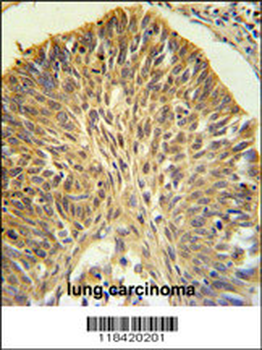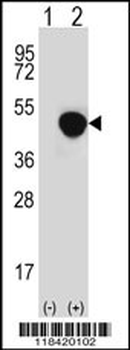You have no items in your shopping cart.
LRG1 Antibody (N-term)
Catalog Number: orb1929870
| Catalog Number | orb1929870 |
|---|---|
| Category | Antibodies |
| Description | Purified Rabbit Polyclonal Antibody (Pab) |
| Species/Host | Rabbit |
| Clonality | Polyclonal |
| Clone Number | RB18420 |
| Tested applications | FC, IHC-P, WB |
| Reactivity | Human |
| Isotype | Rabbit IgG |
| Antibody Type | Primary Antibody |
| Dilution range | WB: 1:1000, WB: 1:1000, IHC-P: 1:50~100, FC: 1:10~50 |
| Form/Appearance | Purified polyclonal antibody supplied in PBS with 0.09% (W/V) sodium azide. This antibody is prepared by Saturated Ammonium Sulfate (SAS) precipitation followed by dialysis against PBS. |
| Conjugation | Unconjugated |
| MW | 38178 Da |
| Target | This LRG1 antibody is generated from rabbits immunized with a KLH conjugated synthetic peptide between 86-114 amino acids from the N-terminal region of human LRG1. |
| UniProt ID | P02750 |
| NCBI | NP_443204.1 |
| Storage | Maintain refrigerated at 2-8°C for up to 2 weeks. For long term storage store at -20°C in small aliquots to prevent freeze-thaw cycles |
| Alternative names | Leucine-rich alpha-2-glycoprotein, LRG, LRG1, LRG Read more... |
| Note | For research use only |
| Expiration Date | 12 months from date of receipt. |

LRG1 Antibody (N-term) flow cytometric analysis of HL-60 cells (right histogram) compared to a negative control cell (left histogram). FITC-conjugated goat-anti-rabbit secondary antibodies were used for the analysis.

LRG1 Antibody (N-term) IHC analysis in formalin fixed and paraffin embedded lung carcinoma followed by peroxidase conjugation of the secondary antibody and DAB staining. This data demonstrates the use of the LRG1 Antibody (N-term) for immunohistochemistry. Clinical relevance has not been evaluated.

Western blot analysis of LRG1 Antibody (N-term) in HL-60 cell line lysates (35 ug/lane). LRG1 (arrow) was detected using the purified Pab.

Western blot analysis of LRG1 (arrow) using rabbit polyclonal LRG1 Antibody (N-term). 293 cell lysates (2 ug/lane) either nontransfected (Lane 1) or transiently transfected (Lane 2) with the LRG1 gene.


